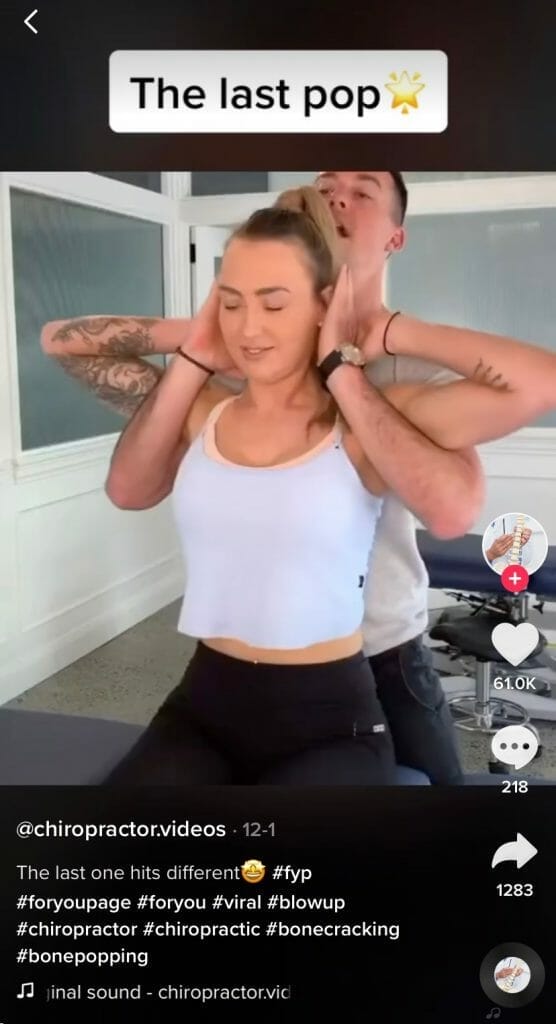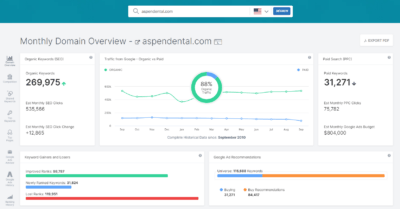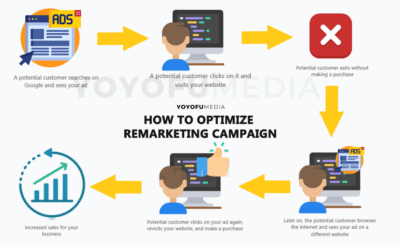Learning how to get your chiropractic clinic ranking on search engines like Google? Want to understand why some websites rank higher than others? SEO or search engine optimization is the answer.
SEO for Chiropractors can help your office become more visible on the search engine results page (SERP). This is useful for all search engines: Google, Yahoo, Bing, etc.
By implementing SEO on your chiropractic website, you can drive traffic to your site and create brand awareness. This will eventually allow you to increase your patient list by organically ranking higher and higher.
To start, you can schedule a free strategy session with SEO experts, or you can keep reading for more information.
Table of Contents
ToggleWhat is SEO, and how do you do it?
Search Engine Optimization, or SEO, is the process of improving your chiropractic website so that it appears higher in search engines like Google when potential patients are looking for services you provide. For example, when someone types “chiropractor near me,” “back pain relief in Los Angeles,” or “sports chiropractor for athletes,” SEO helps make sure your clinic is visible at the top of those results instead of buried on page two or three.
SEO is not just about adding keywords; it’s about creating a trustworthy, user-friendly online presence that signals to both Google and your prospective patients that your clinic is reputable, relevant, and the best choice for their needs. By investing in SEO, chiropractors create a steady flow of new patient inquiries without relying solely on paid advertising.

Benefits of SEO for Chiropractors
One of the main benefits of implementing SEO for chiropractors is that it is free, unlike Google or Facebook ads. You are able to add techniques and strategies to your site and off your site to help your rankings without needing to spend money. However, you will need to spend time properly understanding and implementing.
Difference Between SEO and Google Ads
Many chiropractors wonder whether they should focus on SEO or spend money on Google Ads. The truth is, both strategies have their place, but they work very differently. SEO is an organic strategy that takes time and effort to build but pays off in the long run. When your website ranks high in organic search results, you consistently attract new patients without having to pay each time someone clicks on your site.
On the other hand, Google Ads is a paid strategy. You bid on specific keywords like “chiropractor in Los Angeles” and your clinic appears at the top of search results instantly, but you are charged for every click. While Google Ads delivers fast visibility, the traffic disappears as soon as you stop paying. SEO, in contrast, builds lasting visibility that continues to work for you 24/7. Ideally, chiropractors should use both Google Ads to capture immediate leads and SEO to create a long-term foundation that lowers marketing costs over time.
Local SEO
For chiropractors, local SEO is arguably the most important part of digital marketing because chiropractic care is almost always delivered in person. Patients are not just searching for “chiropractor,” they are searching for “chiropractor near me” or “best chiropractor in Los Angeles.” Local SEO ensures that your practice shows up in these location-specific searches and, more importantly, in Google’s “local 3-pack” map results. To achieve this, your clinic’s name, address, and phone number must be listed consistently across your website and all online directories.
In addition, building reviews on Google and health platforms helps increase your chances of ranking higher locally, since Google favors businesses with more positive engagement. Local content creation also strengthens this effort. Writing blog posts about community health, posture tips for office workers in your city, or stretches for local athletes gives your website a geographic advantage, making it more relevant to patients searching nearby.

Google Business Profile (Previously Google My Business)
Your Google Business Profile, previously known as Google My Business, is one of the most powerful tools for attracting chiropractic patients. This profile is what shows up on Google Maps and in the box of local business listings that appear when someone searches for a chiropractor in your area. An optimized profile gives patients essential information at a glance, including your location, phone number, business hours, and even photos of your clinic.
To maximize its effectiveness, you should complete every section of your profile with accurate and up-to-date details, add all the chiropractic services you provide, upload high-quality images, and post updates about your clinic. Patient reviews are also a crucial factor in how your profile performs. The more reviews you collect and the more consistently you respond to them, the more likely Google is to view your practice as active and trustworthy. This makes your profile not only a listing but also a patient acquisition tool.
Why SEO is Important for Chiropractors
The importance of SEO for chiropractors cannot be overstated. The vast majority of patients research healthcare providers online before ever setting foot in a clinic, and if your practice is not visible when they search, you are effectively invisible to a large segment of your potential audience. Ranking on the first page of Google does more than drive traffic; it builds trust. Patients often associate top-ranking chiropractors with credibility, professionalism, and authority.
Additionally, SEO is one of the most cost-effective marketing channels available. Unlike paid ads, which require constant spending, SEO builds long-term visibility that continues generating patient leads without extra cost per click. For chiropractors competing in crowded markets, SEO is also a way to stand out. By appearing consistently in local search results, on maps, and in organic listings, your practice becomes the default choice for patients who are ready to book.
Competitive Offer
Even the best SEO strategy can be made stronger when combined with a competitive offer that motivates patients to take action. Once people find your clinic online, you need to give them a reason to choose you over the other chiropractors they see listed. This is where an attractive patient offer comes in. Many clinics successfully use promotions such as free initial consultations, discounted first adjustments, or wellness packages that bundle multiple sessions at a reduced rate.
Others focus on adding extra value, like complementary posture assessments or ergonomic workshops for office workers. When these offers are highlighted on your website, Google Business Profile, and social media channels, they turn online visibility into booked appointments. SEO brings patients to your digital doorstep, but a strong competitive offer helps convert them into loyal, paying patients.
If your time is too valuable to spend learning SEO, we can do all the work for you!
On-page SEO for your Chiropractic Site: Content on your Website
On-page SEO is the foundation of any successful chiropractic SEO strategy because it focuses on the elements of your own website that directly affect search rankings and user experience.
By optimizing these factors, you make it easier for Google to understand what your pages are about while also creating a smoother experience for patients who visit your site. A well-optimized website not only ranks higher but also builds trust, keeps visitors engaged, and guides them toward booking an appointment.
URL Structure
The URL structure is another determining factor in your site’s success with SEO. It is recommended to keep your URLs concise while including your keywords. These are words you would like to show up for in the SERP.
As the list goes on, the URL becomes shorter. These are examples of how it may be set up on your or another chiropractor’s site. The separation of slashes means these are separate pages.

If you do not have an entire list of symptoms and disorders, then there is no need to create a page for it. If you specialize in arthritis care, then your URL structure should look like the third example. Any service that you specialize in or that is important to your practice should have its own separate page instead of being found under symptoms and disorders or services.
Title Tags
Title tags are the first thing patients see in Google’s search results, so they need to be both optimized and compelling. A good title tag should include your primary keyword as well as your location, since chiropractic services are highly local.
For example, “Chiropractor Fresno, CA Near Me | Walk In $29 Special” is far more effective than a vague title like “Welcome to Our Clinic.” The right title tag tells both Google and patients exactly what you offer and where you’re located, which increases the likelihood of clicks and higher rankings.

Image Alt-tags
Image alt-tags are an accessibility feature that helps the visually impaired. It allows you to include a description of any images you include on your site. Not only is this helpful and makes your site more accessible, but it can also help with SEO.
You can offer context to your images, which allows search engines to understand them. This will lead Google’s bots to crawl your chiropractic site more efficiently.
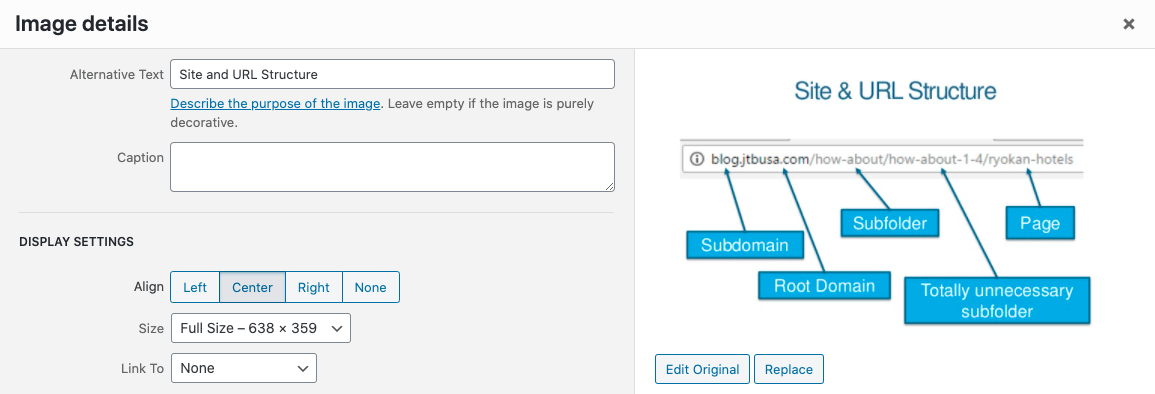
Meta Descriptions
Meta descriptions are the captions below a title in the SERP that offer information about the website or page.

This appears anytime you show up in a search for something, so it must be eye-catching. This is another chance to grab a searcher’s attention, so include relevant information and keywords. Every single page and post on your site needs a meta description.
With your homepage, you can include keywords about your services and location. Tell people about what you do and how long you have been doing it.
You can include testimonials or chiropractic awards you have won as well. Keywords for your services page should be all services you offer and any important details about your care, specifically.
How does this knowledge about search intent help build your website?
Internal and Outbound Links
Internal and outbound links add value to pages on your site. You are showing Google that these may be trusted and serve as a vote of confidence in whatever you link to. Internal links are links back to other pages on your site. Outbound links are links to other websites.
These are super important to use because you are offering readers and Google more information about whatever it is you wrote about. This allows you to rank higher in the SERP.
You should only use internal links to offer more context, and not just randomly link to other pages on your website. Only add when you believe it will further the understanding of the viewers.
An example of this would be adding a link to the address and booking information in a blog post announcing a new location for chiropractic services.

It is a perfect example of internal linking because it offers the reader more information on the contact information to book an appointment.
As for outbound links, they are equally important. This shows Google there is a connection between your site and the one you are linking to. Therefore, it is recommended to link to websites that are trusted, well-known, and relevant to the chiropractic industry.
Compress Large Image Files
Large, uncompressed images can slow down your website, frustrating visitors and hurting your rankings. Since many patients will access your site on mobile devices, page speed is critical.
Compressing images reduces file size without sacrificing quality, ensuring faster loading times. Tools like TinyPNG or built-in website plugins make this easy. A faster website improves user experience, keeps bounce rates low, and signals to Google that your site is reliable.
Improve Readability Level
Search engines favor content that is clear and easy to read. If your chiropractic website is filled with overly technical terms or long, dense paragraphs, patients may leave before finding the information they need.
Aim to write at a middle-school reading level, using short sentences, simple words, and clear formatting. Breaking up content with headings, bullet points, and visuals also makes it easier for patients to scan. Readability isn’t just about SEO; it’s about building trust by making health information approachable.
Optimize Website
Website optimization goes beyond keywords and images; it’s about ensuring the entire user experience is smooth, fast, and mobile-friendly. A well-optimized site should load quickly, look great on all devices, and make it easy for patients to navigate from one section to another.
This includes having clear menus, an easy-to-find contact page, and visible appointment booking buttons. Google rewards sites that provide a strong user experience, and patients are more likely to choose a chiropractor whose website feels modern, professional, and easy to use.
Is on-page SEO too much to set up on your own?
Understanding Keywords
Keywords are the backbone of SEO because they represent the exact words and phrases that potential patients type into Google when they are looking for chiropractic services. If you understand which keywords matter most to your business, you can align your website content with patient intent and make it easier for search engines to connect your practice with the right audience.
For chiropractors, an effective keyword strategy isn’t just about chasing the most popular phrases; it’s about balancing search volume, competition, and relevance so that your clinic attracts patients who are ready to book an appointment.
Keywords, or words/phrases you would like to rank for, are super important in SEO. These must be researched and planned well.

As for chiropractic SEO, it is best to target keywords that have to do with your services. These can be words that express either research or buying intent. This means that the searcher is intending to find an answer (research) or make a purchase.
Typically, research keywords will not give you a high return on patients, but they still may be useful to you. If you target these types of keywords in your website through blog posts or FAQs, you can consistently answer people’s questions, which will lead them to trust you and possibly book an appointment.
With buying intent keywords, these searchers want to complete a purchase/action. This means you can receive patients from these keywords more quickly.
Examples would be “chiropractor for scoliosis Irvine” or “where to find chiropractic treatment for fibromyalgia.” These are the high-value keywords. They are much harder to rank but are worth more.
It is best not to jam in a ton of keywords into one blog post or FAQ. Use them as necessary.
How to do manual keyword research for chiropractors:
On your preferred search engine, type the keyword that you want to rank for. Let’s say you want to see the type of content that ranks the keyword “chiropractor for knee pain.”
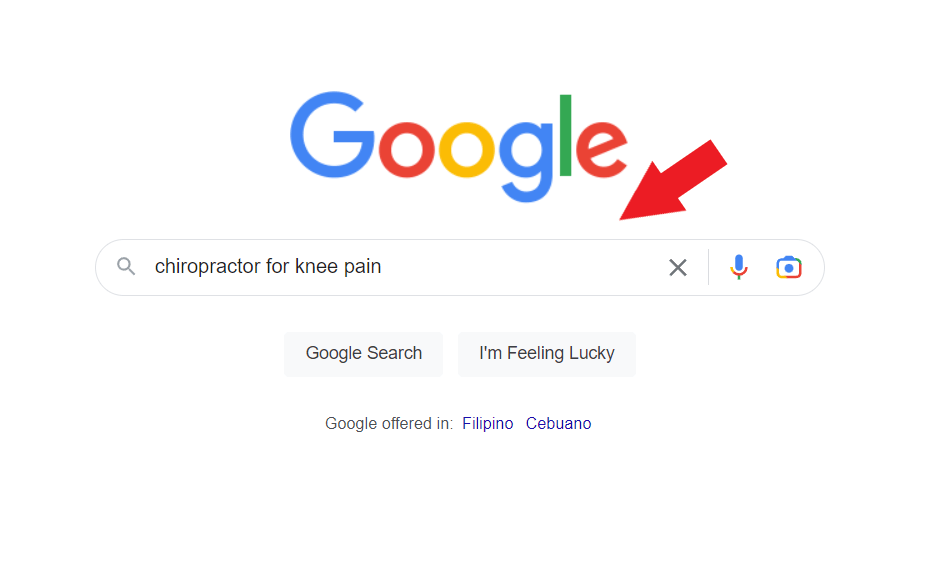
Then, visit each post from your competitors (based on the search results page).
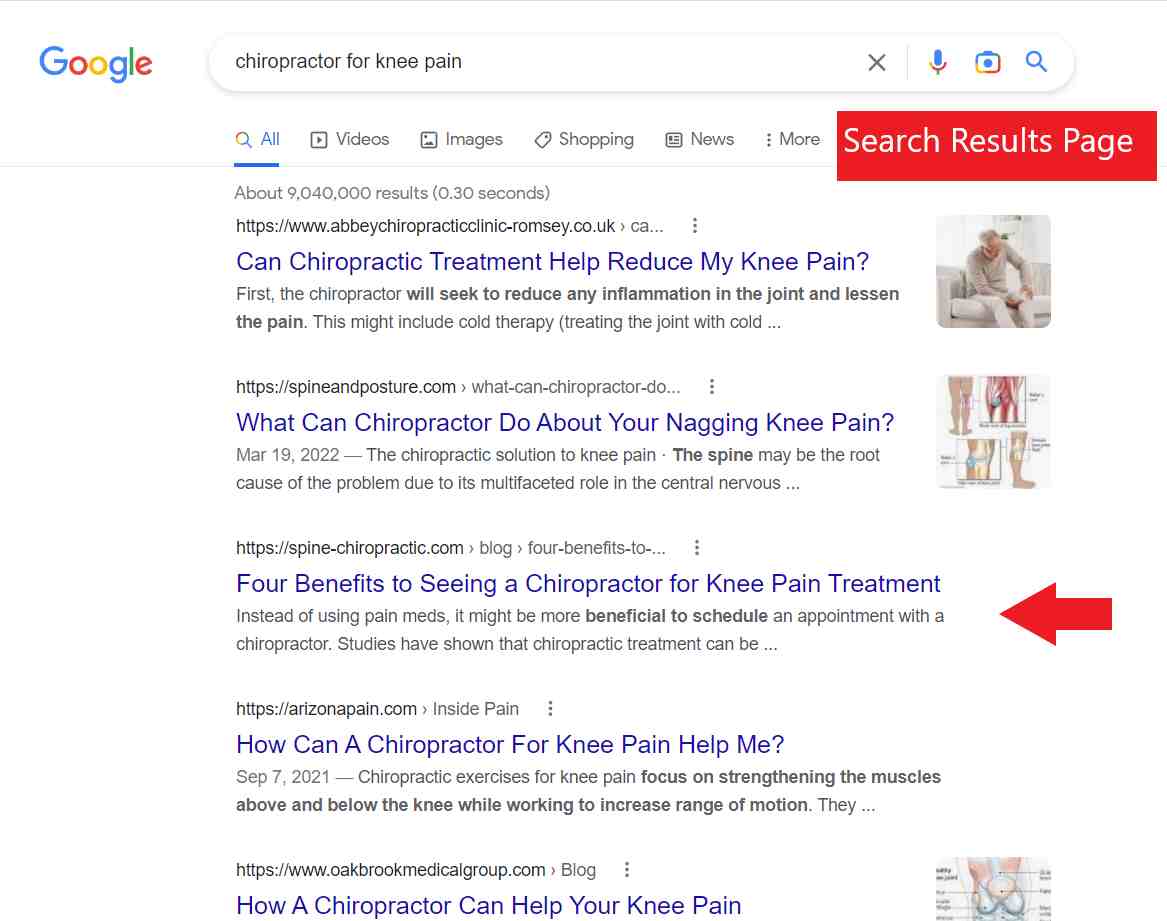
While checking the content for each post, press Ctrl+F. A tiny rectangular box will show up in the upper right corner of the page. That’s where you can enter the keyword that you want to search for on your competitor’s post.
For example, you want to know how many times the phrase “chiropractor for knee pain” was used.
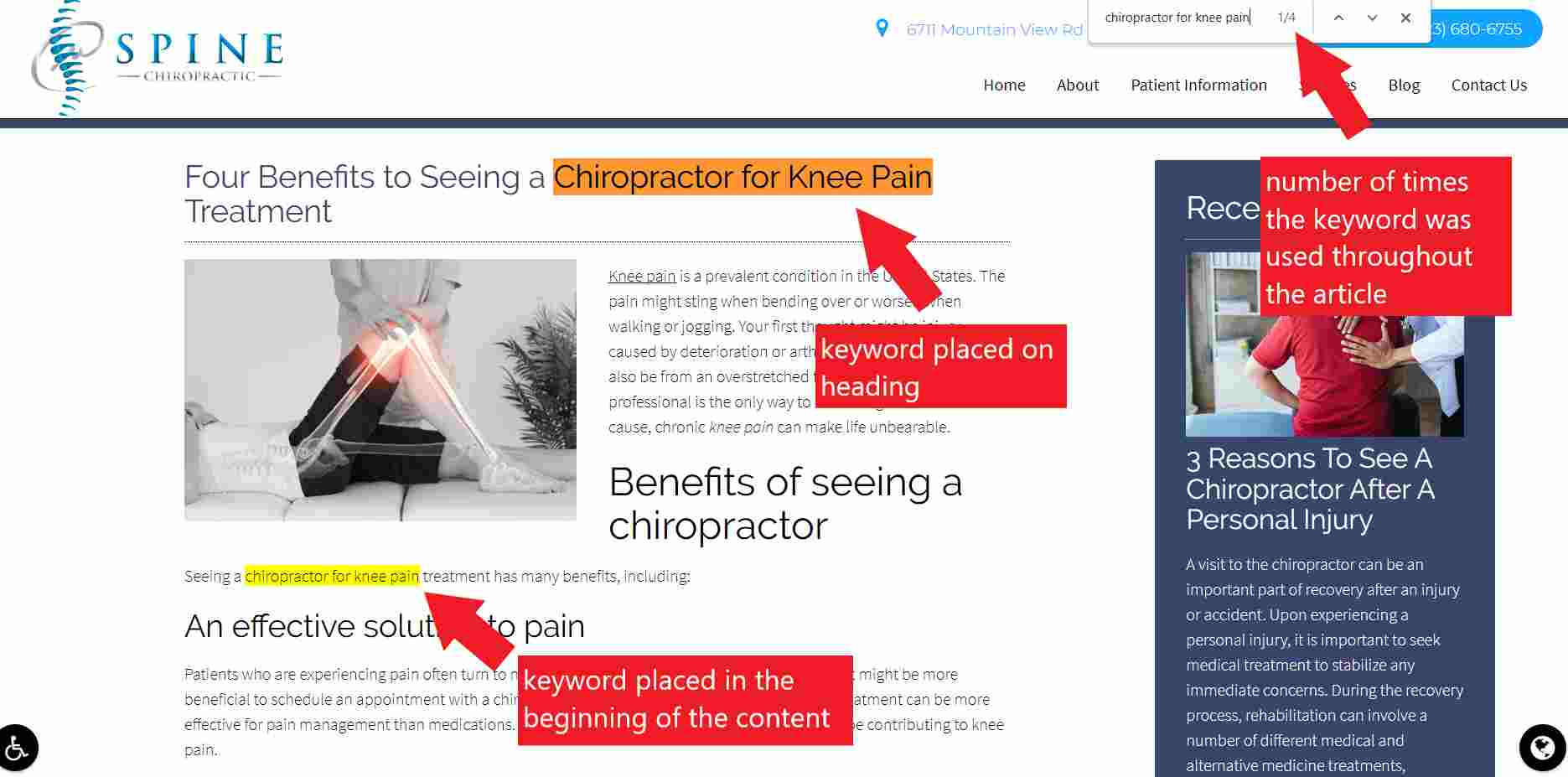
This will give you an idea of the number of times a specific keyword was used on your competitor’s blog posts, along with the strategic places (e.g., headings or at the beginning of the content) to add your keywords and other variations, which will be helpful when you create your future posts.
Learn more about how page speed can impact your chiropractor’s site performance.
Monthly Search Volume
Monthly search volume refers to the number of times a specific keyword is searched on Google in a given month. For example, a keyword like “chiropractor near me” might have thousands of monthly searches, while something more specific like “sports chiropractor in Los Angeles” will have fewer.
High-volume keywords bring in more potential traffic, but they are also more competitive. Chiropractors should target a mix of high- and medium-volume keywords to capture both broad visibility and more niche, conversion-focused traffic.
Keyword Difficulty
Keyword difficulty measures how hard it is to rank for a particular keyword. Competitive keywords like “chiropractor” or “back pain treatment” often have very high difficulty because many clinics and health websites are competing for them.
By contrast, longer, more specific phrases known as long-tail keywords usually have lower difficulty and higher conversion rates. For example, “affordable chiropractor for neck pain in Los Angeles” may not get thousands of searches, but the patients who search for it are highly motivated to book an appointment.
Secure your seo advantage now!
Schedule A Free Strategy Session!
Using Relevant Keywords
The most important rule in keyword strategy is relevance. If you target keywords that don’t match your services or location, you may attract visitors who never convert into patients. A chiropractic clinic in Austin should not waste time trying to rank for “chiropractor in Los Angeles.”
Instead, the focus should be on phrases directly related to chiropractic services you actually offer and the geographic area you serve. Relevant keywords ensure that the patients who find you online are the ones most likely to call your office or schedule an appointment.
Choosing the Right Target Keywords
Choosing target keywords requires a balance of search volume, keyword difficulty, and business goals. Chiropractors should start by targeting a handful of primary keywords like “chiropractor in Los Angeles” or “back pain relief Los Angeles” that are highly relevant and have strong search demand.
From there, you can expand into secondary keywords that support your main services, such as “sciatica treatment,” “chiropractic adjustment for athletes,” or “neck pain chiropractor near me.” By combining broad and specific keywords, you create multiple entry points for potential patients to find your clinic.
Long-Tail Keywords
Long-tail keywords are longer, more specific phrases that may only get a few dozen searches per month but tend to convert better. These keywords usually reflect the exact way people search when they are closer to booking an appointment.
For example, “chiropractor open on Saturday in Los Angeles” or “best chiropractor for pregnancy back pain near me” may not have high search volume, but the patients who type them are actively looking for care. Incorporating long-tail keywords into blog posts, FAQs, and service pages helps chiropractors capture this valuable traffic.
Short-Tail Keywords
Short-tail keywords are broad, generic search terms like “chiropractor” or “back pain.” While they generate a lot of traffic, they are also very competitive and less likely to convert because they don’t reveal strong intent.
Someone searching for “chiropractor” could be looking for a definition, a clinic in another city, or general information. Chiropractors should not ignore short-tail keywords, but they should focus on pairing them with more specific, long-tail terms that capture higher-quality traffic.
Keyword Research Tools
Fortunately, chiropractors don’t have to guess which keywords to target. Several tools make keyword research easier and more accurate.
Google’s autocomplete predictions
Also known as Google Autosuggest, it shows you what patients are actively searching for as you type a query into the search bar.

Google’s Related Searches
Google’s Related Searches, which appear at the bottom of the search results page, provide even more keyword ideas based on real user behavior.

Google Keyword Planner
A free tool inside Google Ads shows search volumes and competition levels for specific keywords.

Ahrefs Free Keyword Generator
Ahrefs Free Keyword Generator to get keyword suggestions and difficulty scores. Using these tools allows you to identify both high-value and overlooked opportunities to target in your SEO strategy.

Want to rank number #1? We can help you!
Tracking Keyword Rankings with Serprobot
Keyword research doesn’t stop once you publish content; you also need to track your rankings to see whether your strategy is working. Tools like Serprobot allow you to monitor where your website ranks for each target keyword over time.
This helps you understand which keywords are improving, which ones are stuck, and which need further optimization. Tracking also helps you measure ROI by showing how your keyword strategy translates into visibility and, ultimately, more patient appointments.

Understanding Search Intent
Search intent refers to the reason behind a user’s Google search, what they are hoping to find when they type in a query. For chiropractors, aligning your website content with the right intent is crucial because it ensures that you show up for patients at every stage of their journey, whether they’re just learning about chiropractic care or ready to book an appointment. There are four main types of search intent: informational, navigational, commercial, and transactional.
Informational Intent
Informational intent means the user is looking for knowledge rather than a service. For example, someone might search for “what does a chiropractor do for back pain” or “is chiropractic care safe during pregnancy.”
At this stage, the user is not yet ready to book an appointment, but they are gathering information that could eventually lead them to a chiropractor. Chiropractors can capture this audience by creating blog posts, FAQs, or educational videos that answer these common questions. Doing so builds trust and positions your clinic as an authority.
Navigational Intent
Navigational intent occurs when someone is searching for a specific brand, website, or location. For example, a person might type in “Dr. Smith Chiropractic Clinic” or “ChiroCare Wellness Center.”
This type of search usually comes from people who already know your clinic by name or have seen it elsewhere and want to find your website quickly. To serve navigational searches, chiropractors should make sure their website ranks for their business name, keep their Google Business Profile updated, and ensure consistency across directories.
Commercial Intent
Commercial intent lies in the middle of the patient journey. These users are actively researching their options and comparing providers before making a decision. They might search for “best chiropractor in Los Angeles,” “affordable chiropractor near me,” or “sports chiropractor reviews.”
At this stage, the user is interested in chiropractic care but wants to evaluate their choices. Chiropractors can capture this intent by showcasing patient reviews, highlighting their specialties (sports injuries, prenatal care, sciatica treatment, etc.), and creating service pages that clearly explain why their clinic stands out.
Transactional Intent
Transactional intent means the patient is ready to take action, typically booking an appointment. Searches at this stage include phrases like “chiropractor near me open now,” “book chiropractor online Los Angeles,” or “walk-in chiropractor Saturday.” These users have high conversion potential because they are looking for immediate care.
Chiropractors can capture transactional intent by making sure their website has clear calls-to-action (like “Book Appointment” buttons), easy-to-use online booking systems, and location-based SEO that ensures they appear in local searches and map results.
Off-page SEO
While on-page SEO focuses on optimizing elements within your website, off-page SEO refers to all the strategies you use outside of your website to boost your search engine rankings and credibility.
For chiropractors, off-page SEO is about building authority, visibility, and trust so that both Google and potential patients view your practice as a reliable and reputable provider. Strong off-page signals can mean the difference between ranking on page two and securing a top spot in local search results.
Off-page SEO for chiropractors includes:
- Backlinks
- Google My Business
- Citations
- Social Media
These are all things you can work on outside of your site to perform better in the SERP.
Backlinks
As mentioned earlier, links are very important in SEO. Backlinks are links back to your site and show Google that others trust your site and content. It is super important to obtain quality backlinks from other trusted sites in your industry or from a local news publication.
Quality links mean that spending money on sketchy link-building sites is not the way to go. Since this is an SEO for chiropractors guide, it is best to do outreach and ask for others who are practicing at your chiropractic office for links on their websites.
You can check where you are obtaining backlinks from on Ahrefs Backlink Checker.
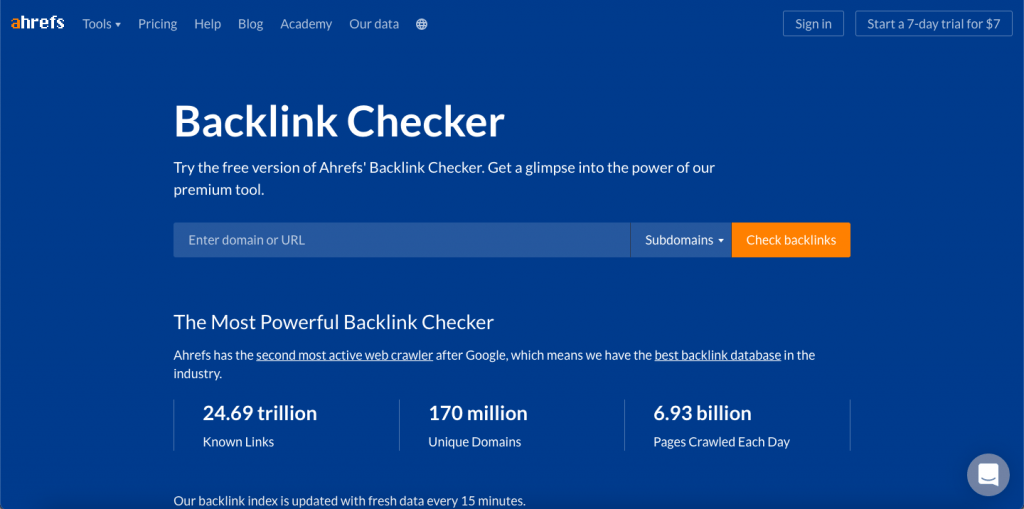
Google My Business (Profile and Reviews)
To increase your brand awareness and digital presence, you should create a Google My Business account. This is another chance to add your business’s information on Google, such as contact info, address, and more.
By creating this account, you are more likely to get found and bring in potential clients.
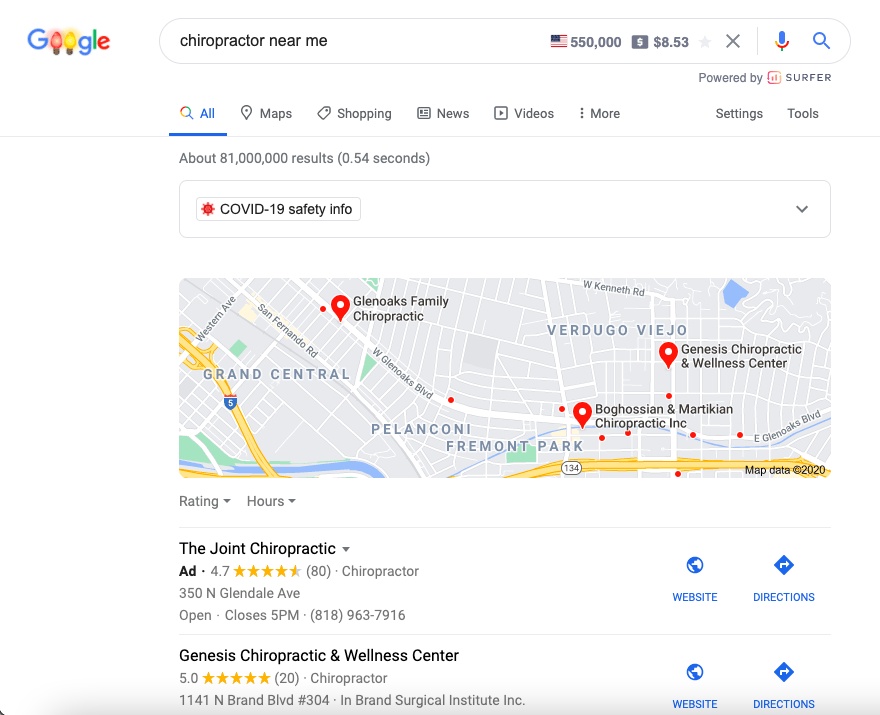
While searching for “chiropractor near me,” Google Maps suggestions show up first with information from Google My Business. This can be your practice of showing up first to all locals who search.
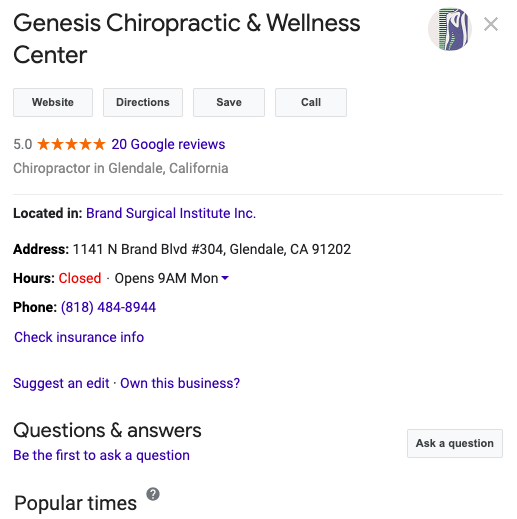
There are reviews and a questions/answers section on each profile.
It is best to respond to every review and question asked. Even questions that can be answered from your profile or website should still be answered. This shows that you care about prospective patients.
With reviews, you should respond to all of them. Bad reviews should have a response to let others know that you value customer feedback. You can also respond to all the nice reviews to let them know that you are happy that patients were satisfied with their care.
While you don’t have control over what your reviewers write about, you can control what you write in your responses. Inserting relevant SEO chiropractic keywords into your responses will rank your clinic higher on the Google map pack.
You can always ask your patients to leave reviews on Google. You can even include a section on your website that links to your Google My Business profile so they can leave a review.
If you want to appear in more Google searches, use PPC for chiro practices.
Got questions about SEO for Electricians?
Guest Posting
Guest posting is one of the most effective ways to earn backlinks while also expanding your reach. Chiropractors can contribute articles to local newspapers, health and wellness blogs, or fitness websites.
Topics might include “5 Stretches to Reduce Back Pain at Work” or “How Chiropractic Care Helps Athletes Recover Faster.” By writing guest posts, you showcase your expertise, provide value to new audiences, and gain a backlink to your website. This not only boosts your authority but also drives targeted traffic from people already interested in health and wellness.
Content Marketing
Content marketing goes beyond blog posts. For chiropractors, it can include creating infographics about spinal health, recording YouTube videos demonstrating posture tips, or publishing eBooks about injury prevention.
The goal is to provide valuable, shareable content that spreads across the web and naturally attracts backlinks. For example, a detailed guide on “Chiropractic Care for Desk Workers” could be picked up by HR professionals or wellness coaches and shared widely, driving traffic and recognition to your clinic.
Online Forums
Online forums and Q&A platforms such as Reddit, Quora, and specialized health discussion boards provide opportunities for chiropractors to showcase expertise.
By answering questions like “What’s the difference between a chiropractor and a physical therapist?” or “How do chiropractors help with migraines?” you build authority and can include subtle references to your clinic. While you should avoid spamming links, providing genuinely helpful answers can drive referral traffic and strengthen your reputation as a trusted professional.
Citations
Citations/online directories are another place outside of your website where you can let others know about your practice. This will give you more links and reach other audiences. Citations are websites like Yellow Pages, Yelp, and LinkedIn.
One way to determine which online directories may be worth it is by checking where your competitors are registered. You can check their sites on the Ahrefs backlinks checker and scroll through to see which directories they are on. Then you can register for each one.
Another citation you should register for is Apple Maps. You have to have an Apple ID to set it up and then input all of your practice’s information.
Will search engine optimization competitor research take up too much of your time?
Social Media Marketing
It is key for businesses to have social media accounts, even chiropractic offices. This allows you to offer social proof of your services to people. It will let others know that you are trusted.
People love to see before and after photos/videos as well as progress videos. For chiropractors, especially, people love seeing videos of services. It would be very beneficial to use a social media platform that allows you to post videos.
Instagram, Facebook, TikTok, and YouTube are all great choices. You can repurpose your content across all these platforms.
If you create a longer video on YouTube, you can shorten parts of it to create a TikTok video or Reel on Instagram. Or if you create TikTok videos, you can create a compilation of them for YouTube.
You can also implement your keyword research into these chiropractor social media apps through hashtags. Search engine optimization also extends to these apps.
Work with SEO experts who care about results.
Technical SEO
The third part of SEO is the technical aspect. This focuses on optimization for the search engine’s bots that crawl your website. Google Search Console can be very important in this aspect of SEO.
On Google Search Console, you can submit the URLs of your website’s pages so Google can index them. It will let you know if there are any issues with your site and what you need to improve on.
You can also submit an XML sitemap that allows Google to understand your site better. It will let the bots know where your content is located.
If you have a WordPress site, many plugins make using an XML sitemap easy, like Yoast.
There is a lot more that goes into technical SEO, like 404 pages and canonical URLs. However, there should be a lot of research that goes into these techniques.
Website Security (HTTPS)
Google prioritizes secure websites, and patients expect their personal information to be protected. If your website still uses HTTP instead of HTTPS, it may show a “Not Secure” warning in browsers, which can scare visitors away. For chiropractors, this is especially important if you offer online booking forms or collect patient inquiries.
Setting up an SSL certificate to enable HTTPS ensures that all data exchanged between your website and patients is encrypted, building trust and meeting Google’s security requirements.
Page Speed
Slow-loading websites frustrate users and can lead to high bounce rates. Google has confirmed that page speed is a ranking factor, which means a fast website gives you an advantage over slower competitors.
Chiropractors should aim for a website that loads in under three seconds. Common ways to improve speed include compressing images, reducing unnecessary plugins, enabling browser caching, and using a reliable hosting provider. A fast site keeps visitors engaged, increases conversions, and improves your search rankings.
Mobile-Friendly Website
With most patients searching for chiropractors on their smartphones, having a mobile-friendly website is no longer optional. Google uses mobile-first indexing, meaning it primarily looks at the mobile version of your site when determining rankings.
A mobile-optimized chiropractic website should have a responsive design (automatically adjusting to any screen size), clickable phone numbers, and easy-to-navigate menus. Patients should be able to book appointments, find directions, and read about your services effortlessly on their phones.
Keyword Cannibalization
Keyword cannibalization happens when multiple pages on your site target the same keyword, causing them to compete against each other instead of boosting your rankings. For example, if you have several separate pages optimized for “chiropractor in [city],” Google may not know which one to prioritize.
Chiropractors can fix this issue by consolidating similar pages into one comprehensive page or adjusting keyword targeting so each page focuses on a unique topic. This makes your site more organized and signals to Google which page deserves to rank.
Fix Duplicate Content
Duplicate content confuses search engines and can prevent your website from ranking properly. Chiropractors often run into this issue when using templated service descriptions, copying content from manufacturer websites (for equipment), or having multiple versions of the same page.
Tools like Copyscape or Screaming Frog can help identify duplicate content. The solution may involve rewriting content, setting up canonical tags, or redirecting duplicate pages to a single version. Original, unique content is always more valuable for both SEO and patient trust.
Fix Broken Links
Broken links (404 errors) harm user experience and send negative signals to search engines. If a patient clicks on a service page or blog post that doesn’t load, they may leave your site immediately.
Chiropractors should regularly audit their websites using tools like Ahrefs or Google Search Console to find and fix broken links. Updating old URLs, redirecting removed pages, or correcting typos in links ensures patients and Google can always navigate your site smoothly.

Improve User Experience (UX)
Google pays close attention to how visitors interact with your website. If patients find it easy to navigate, stay longer, and engage with your content, your rankings improve.
A good chiropractic website should have a clean design, clear service pages, visible contact information, and strong calls-to-action like “Book Your Adjustment Today.” Adding features like online booking, location maps, and patient testimonials can further enhance the user experience and increase conversion rates.
Analytics and Monitoring Your Website
The only way to know if your SEO is working is to track and measure results. Chiropractors should set up Google Analytics and Google Search Console to monitor website traffic, keyword rankings, and user behavior.
These tools provide insights into which pages bring in the most patients, how long people stay on your site, and which keywords are driving traffic. By consistently reviewing analytics, you can make data-driven improvements to your SEO strategy, ensuring your chiropractic clinic continues to grow online visibility.
Loading Speed
The loading speed aspect refers to how fast your website loads. It must load fast, or you will miss out on traffic from viewers. 1 in 4 searchers will exit a website that takes longer than 4 seconds to load. Keep in mind that you can be deterring viewers by having slow pages.
GTmetrix and Pingdom are great sites to check the loading speed of your chiropractic website. It will let you know of any issues.
If your website is not performing as well as you want, you must check the image sizes on your site. This is usually the culprit for a slow site. You should compress all images on your site by using a plugin or other tool to help.
Autoptimize and Smush are simple WordPress plugins that will allow you to decrease the loading time.

If You Work With Us, You Won’t Have To Worry About The Things That Could Make Or Break Your SEO!
AI SEO (a.k.a. LLM SEO, GEO, GSEO, ChatGPT SEO)
AI SEO, also called Large Language Model SEO (LLM SEO), Generative Engine Optimization (GEO), or ChatGPT SEO, is the practice of optimizing your content so that it appears in answers generated by AI-powered search engines like ChatGPT, Google Gemini, and Perplexity.
Unlike traditional Google search, which shows a list of website links, these AI systems generate summaries, recommendations, and explanations by pulling from online sources. This means chiropractors must now think about how their content can not only rank in Google but also be selected and referenced by AI-driven platforms.
Similarities with Traditional SEO
At its core, AI SEO shares many similarities with traditional SEO. Both require high-quality, trustworthy, and well-structured content that provides real value to readers. Just like Google’s algorithm, AI systems look for content that is authoritative, relevant, and easy to understand. If your website is already optimized with clear headings, helpful blog posts, strong local SEO signals, and positive online reviews, you are already building the foundation needed to perform well in AI-generated results.
Key Differences in AI SEO
The main difference between traditional SEO and AI SEO lies in the type of content that gets surfaced. AI tools don’t just rely on keyword density or backlinks; instead, they prioritize originality and freshness. If your website publishes content that looks identical to everything else online, AI systems are unlikely to reference it, because the information already exists in their models.
However, when your clinic shares unique insights such as case studies, patient success stories, local chiropractic statistics, or wellness advice specific to your community, this becomes new knowledge that AI systems recognize as valuable. The more new information you create that AI doesn’t already have, the higher your chances of being included in generated responses.
The Role of Different Content Types
AI-powered platforms also pull from a variety of sources beyond traditional websites. YouTube videos, for example, play a significant role because AI tools often analyze transcripts to extract answers and summaries.
By publishing educational videos such as posture tips, back pain stretches, or explanations of chiropractic techniques, your clinic can increase its chances of being mentioned in AI-generated search results. PR articles, local news features, and press releases also perform well in AI SEO, since they provide fresh, newsworthy information that AI tools tend to prioritize when summarizing the latest updates.
How Different AI Systems Prioritize Content
Not all AI systems evaluate content the same way, and their algorithms are constantly changing as they update. ChatGPT typically favors content that is structured clearly, provides direct answers, and is written in an authoritative yet conversational style. Gemini, because of its connection to Google, leans heavily on websites that already perform well in traditional SEO, which means your rankings in Google often influence how Gemini references your content.
Perplexity takes a slightly different approach, as it prioritizes sources that are easy to cite and fact-check, often showing direct attributions and links. These differences highlight the importance of diversifying your content strategy to meet the evolving standards of multiple AI platforms.
How does this knowledge about search intent help build your website?
Common SEO Mistakes to Avoid
Even the best chiropractic websites can fall short if they make common SEO mistakes. Many chiropractors invest time and money into building an online presence, but accidentally sabotage their results by overlooking critical details. Understanding and avoiding these pitfalls will help ensure that your SEO strategy delivers consistent traffic, better rankings, and more new patients.
Keyword Stuffing and Over-Optimization
One of the most widespread mistakes in SEO is keyword stuffing, the practice of cramming the same phrase into a page too many times in an attempt to rank higher. For example, a chiropractor might repeat “best chiropractor in Los Angeles” five times in one paragraph, making the content awkward and unnatural. While this might have worked years ago, today Google’s algorithms can easily detect over-optimization. Instead of rewarding these pages, search engines now penalize them by lowering their rankings.
For chiropractors, this not only hurts SEO but also damages patient trust. When a potential patient visits your site and reads content that feels robotic or repetitive, they may question the professionalism of your clinic. The solution is to use keywords naturally, vary your phrasing, and focus on creating content that answers patient questions clearly. For example, instead of repeating the same phrase, you might use variations like “chiropractic care in Los Angeles,” “back pain specialist nearby,” or “trusted chiropractor for families.” High-quality, natural content always wins over forced optimization.
Neglecting Mobile Optimization
With the majority of patients searching for chiropractors on their phones, ignoring mobile optimization is one of the fastest ways to lose potential clients. A site that looks perfect on a desktop but is difficult to navigate on a smartphone creates a frustrating experience. Buttons may be too small, text may be hard to read, or pages may load slowly. Patients looking for quick solutions, such as finding your clinic’s phone number or booking an appointment, will simply leave and choose a competitor if your site isn’t mobile-friendly.
Google also uses mobile-first indexing, meaning it primarily looks at the mobile version of your site when deciding how to rank you. This means even if your desktop site looks professional, your rankings will drop if the mobile version is lacking. Chiropractors should ensure their websites are fully responsive, with clear menus, clickable phone numbers, fast loading speeds, and booking options that work seamlessly across all devices. A smooth mobile experience doesn’t just improve SEO; it also increases patient conversions.
Ignoring User Experience
SEO isn’t just about pleasing search engines; it’s about creating a great experience for real people. Many chiropractors focus heavily on keywords and backlinks, but forget that the ultimate goal is to guide a patient from curiosity to booking an appointment. If your site is cluttered, slow, or difficult to navigate, users will leave quickly, signaling to Google that your site isn’t providing value. This leads to lower rankings and fewer leads.
User experience (UX) covers everything from your website’s design to how easy it is to find information. Chiropractors should prioritize clean layouts, clear service pages, visible contact information, and easy booking options. Adding patient testimonials, FAQs, and blog posts that answer common questions can also improve engagement. Remember, Google’s algorithms increasingly measure how users interact with your site. If visitors stay longer, click through multiple pages, and book appointments, it’s a strong signal that your site is helpful and your rankings will improve as a result.
Recap of SEO for Chiropractors
SEO is not a one-time set-it-and-forget-it strategy. It is something you must continue to work on and monitor. Rankings fluctuate, so it is important to notice what works and what doesn’t work.
On-page SEO consists of your loading speed, URL structure, meta descriptions, image alt-tags, and internal and outbound links. For your off-page SEO, you should try to obtain quality backlinks and sign up for citations/online directories like Google My Business and Apple Maps. As for the technical aspect, you can request indexing on Google Search Console to allow the bots to crawl your site.
You should start optimizing your site today to become visible to potential patients.
Don’t have the time to start and maintain?


